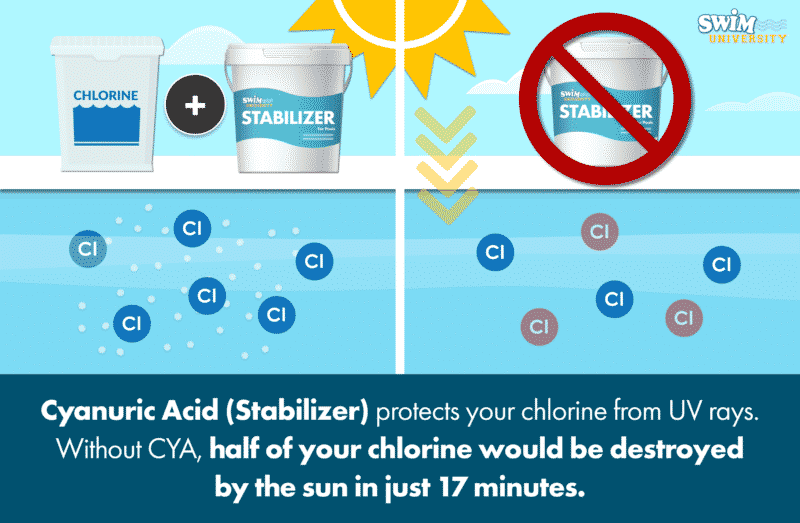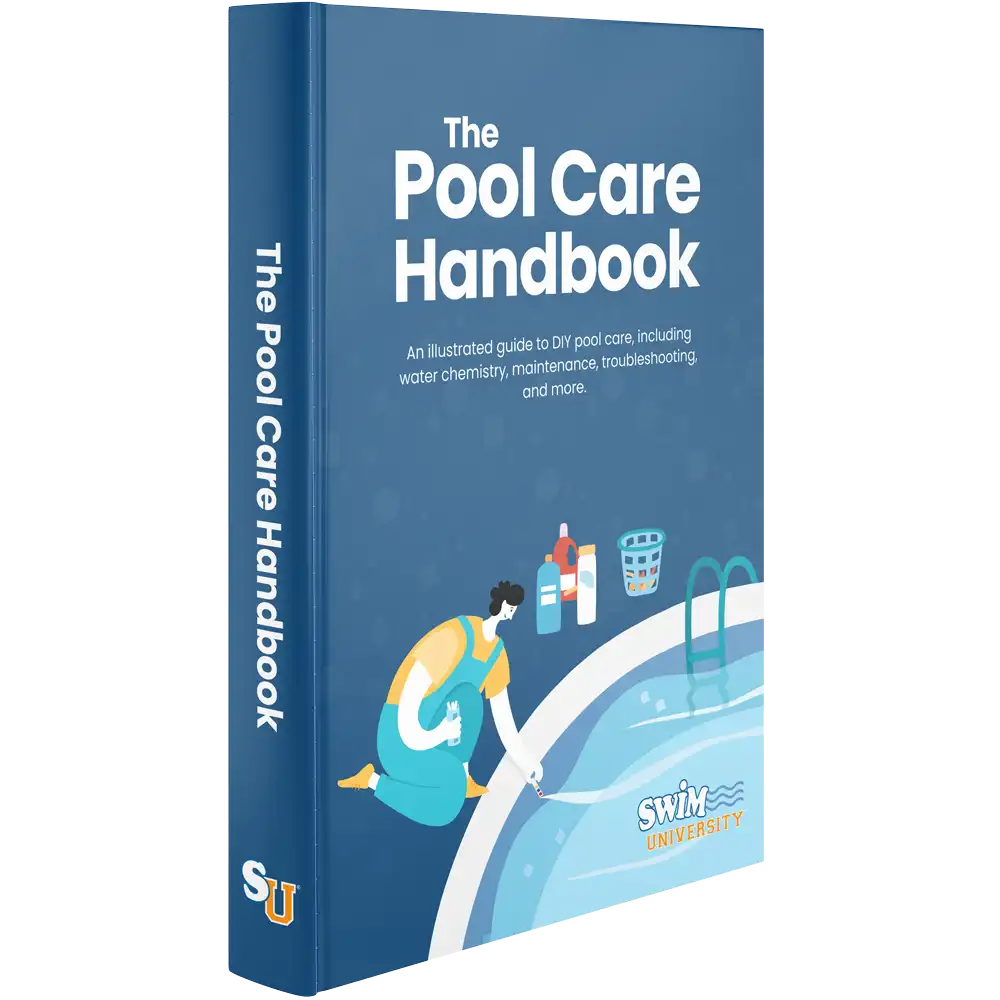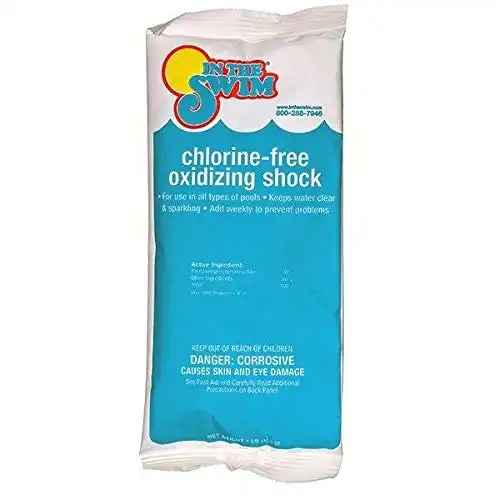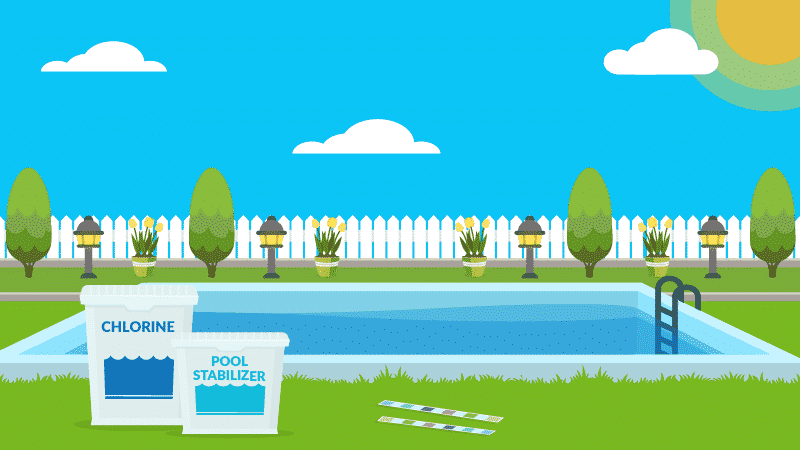Cyanuric Acid: Why Your Pool Needs It and How To Balance It
Cyanuric acid (CYA), also known as chlorine stabilizer or pool conditioner, is a critical chemical that stabilizes the chlorine in your pool. Without cyanuric acid, your chlorine will quickly break down under the sun’s ultraviolet rays.
But having too little or too much CYA in your pool can inhibit your chlorine’s effectiveness and even damage your pool equipment. That’s why maintaining the right cyanuric acid levels is so important to help your chlorine actively kill bacteria, contaminants, and algae.
Here’s everything you need to know about how cyanuric acid interacts with chlorine and how to maintain the right CYA levels in your pool.
You can watch the quick video tutorial below. Or keep reading for the step-by-step guide on how to adjust your CYA levels.
This is the ultimate guide to keeping your pool sparkling clean throughout the year that contains everything you need to know about taking care of your pool the right way.
How Does Cyanuric Acid Work in a Pool?
Cyanuric acid, or chlorine stabilizer, reduces the amount of chlorine that’s destroyed by the sun’s UV rays. CYA helps your chlorine last longer, which means your chlorine can sanitize your pool water longer.
If you have an outdoor pool without CYA or stabilizer, your chlorine will dissipate in a few hours, leaving your pool unprotected and unsanitized. In fact, it only takes 17 minutes of exposure to UV rays to destroy half of your chlorine. Imagine a chlorine tablet losing half of its chlorine in such a short period of time!

Pools with very low or no cyanuric acid experience “chlorine demand,” or the inability to maintain chlorine levels. No matter how much chlorine you add, the levels drop quickly. Chlorine without CYA, also known as unstabilized chlorine, is destroyed by UV rays very quickly. Adding stabilizer helps your chlorine last 3-5 times longer.
But not every pool owner needs to worry about CYA levels. Because cyanuric acid protects chlorine from the sun, it’s really only required for outdoor pools (or indoor pools with some ultraviolet light exposure). CYA stays in a swimming pool for a long time, even after the water evaporates. So always check your cyanuric acid levels before adding more chlorine stabilizer to your water.
What Are the Right CYA Levels?
The ideal range for cyanuric acid is between 30 and 50 ppm. Too much CYA and your chlorine’s effectiveness decreases. Too little CYA and your chlorine will break down under the sun’s UV rays.
But it’s the ratio of CYA to chlorine that’s most crucial. Your free chlorine levels should be 7.5 percent of your cyanuric acid levels. If your pool has CYA levels at 40 ppm, you’ll need to keep your free chlorine levels at 3 ppm to effectively sanitize your water. And general, your free chlorine levels should be between 1 ppm and 3 ppm.
However, if you’re a saltwater pool owner, you’ll need to maintain higher CYA levels. The sun’s UV rays are doubly harmful to saltwater pools, impacting both the salt itself and the chlorine generated from that salt. Saltwater pool manufacturers recommend keeping your cyanuric acid levels between 60 and 80 ppm.
Remember, more cyanuric acid does not mean more protection from the sun. If your CYA levels are high, you may experience algae growth or cloudy pool water. That’s because your chlorine’s effectiveness is reduced. If your CYA levels are 100 ppm or higher, you may not even be able to get an accurate reading on a test strip.
If your cyanuric acid levels are off the charts, take a water sample into your local pool supply store or use a test kit that measures CYA levels up to 300 ppm.
Stop wasting time and money with confusing water chemistry and maintenance. Our effortless system guarantees to keep your pool balanced, sanitized, and crystal clear all year. Works for all pools including saltwater.
What Causes High Cyanuric Acid Levels?
If you’re adding chlorine to your water, there’s a good chance you’re adding cyanuric acid along with it. Many chlorine products, like trichlor or dichlor granules or tablets, are known as stabilized chlorine products. This means they already come with CYA. Every time you add chlorine to your pool, you’re adding cyanuric acid.
On the other hand, unstabilized chlorine, like liquid chlorine, doesn’t include CYA. You can learn more about the difference between stabilized and unstabilized chlorine here.
If you need to add CYA to your pool, you can buy it as a separate product. It’s usually called pool stabilizer or pool conditioner. Here is the stabilizer we recommend:
Keep your chlorine from being burned off too quickly by the sun's UV rays. CYA will help you keep a better chlorine reading in your pool.
Just be careful how much extra cyanuric acid you add to your water. It’s very hard to lower your CYA levels if they’re too high. And cyanuric acid does not evaporate or break down like chlorine, so it will linger in your pool water. It can even hang around in your filtration system and pool plaster.
How to Lower Cyanuric Acid in Your Pool
The only effective way to lower your CYA is to partially drain your pool and refill it with fresh water. If you think your cyanuric acid is too high, the first step is to stop adding more CYA or stabilized chlorine to your pool before diluting your water.
1. Test Your Pool Water
Test your swimming pool water to see if your CYA levels are between 30 and 50 ppm. If your cyanuric acid levels are 100 ppm or above, you may need to run multiple tests as you bring your CYA levels down. You can also take a water sample to your local pool supply store or purchase a test kit that will measure your cyanuric acid up to 300 ppm.
This complete water testing kit helps keep your pool or hot tub clean and safe to swim in, with easy-to-follow color instructions and all the supplies you need in one box.
2. Stop Using Stabilized Chlorine
Check to see if you’re using stabilized chlorine, which already contains small amounts of cyanuric acid. If you see these chemicals listed on the label, your chlorine contains CYA:
- potassium dichloroisocyanurate
- sodium dichloroisocyanurate
- trichloroisocyanurate
In the short term, switch to chlorine without cyanuric acid to prevent your high CYA levels from getting worse.
3. Dilute Your Pool Water
If the amount of cyanuric acid in your water is very high, you must dilute your pool water. Partially drain some of your pool water by using a manual vacuum on your filter’s waste setting. Then refill your pool with fresh water.
As a general rule of thumb, if your CYA levels are 10% too high, you’ll want to remove and replace about 10% of your pool water. But be aware that cyanuric acid can hang around in your filtration system. So if you have extremely high levels of CYA, you may also want to backwash or change your filter.
4. Circulate and Retest Your Cyanuric Acid Levels
Run your pump for a few hours to circulate the freshwater. Then retest your cyanuric acid levels again. If they’re still too high, repeat the process and dilute more of your pool water.
Do Cyanuric Acid Reducers Work?
Cyanuric acid reducers have mixed results, and the only guaranteed way to reduce your CYA levels is by diluting your water.
Cyanuric acid reducers are biologically based, so they work slowly. It can take a week or more to reduce your CYA levels, and many customers have reported seeing no results.
And CYA reducers are not cheap. You could partially drain and refill your pool for roughly the same price, depending on the water utility costs in your area. But if you can’t dilute your pool water (say because of drought conditions or municipality restrictions), it might be worth trying a cyanuric acid reducer.
How to Raise Cyanuric Acid in Your Pool
If you do need to raise your cyanuric acid levels, you’ll likely only need to add it once or twice per year (usually at the beginning of the season). But be careful about adding too much CYA. Remember that cyanuric acid does not break down in the water and can stay in your pool for a long time. And stabilized chlorine (like dichlor or trichlor) already comes with CYA, so you’ll likely be adding it to your pool water throughout the season.
Because CYA is an acid, you’ll need to handle it carefully. It can damage your filter and your pool, especially if you have a vinyl liner. Here is the safe way to add stabilizer to your pool.
You’ll need the following supplies:
- Cyanuric acid (a.k.a. conditioner or stabilizer)
- A 5-gallon bucket
- Safety goggles
- Acid-resistant gloves
- Protective clothing (i.e. long sleeves, closed-toe shoes)
- Warm water
To add cyanuric acid to your pool:
- Fill the bucket at least halfway with warm water.
- Put on your goggles and gloves.
- Add a dose of stabilizer to the bucket. Check the product instructions for the right dose based on your pool size. As a general rule, add 13 ounces of cyanuric acid to gain 10 ppm of CYA in a 10,000-gallon pool. Remember, your CYA should be between 30 and 50 ppm.
- Pour the contents of the bucket directly into your skimmer.
- Run your pool pump for at least a few hours after. Letting the pump helps mix the solution into your pool.
Note: Some packages of cyanuric acid say to add the chemical directly to the skimmer without first combining it with water. Always read and follow the manufacturer’s instructions.
How to Maintain the Right CYA Levels
Regular water testing will help you maintain the right amount of cyanuric acid in your water. This is especially important if you’re using stabilized chlorine or you tend to have problems with high CYA.
Check your pool chemistry once a week with test strips that measure CYA or cyanuric acid. Remember, your free chlorine levels should be about 7.5 percent of your CYA levels. That means if your free chlorine is at 3 ppm, your levels of cyanuric acid should be around 40 ppm.
Also, be sure to test your water chemistry after a rainstorm. Rainwater will dilute your water and lower your CYA levels.
Frequently Asked Questions about Cyanuric Acid
Looking for more help with using CYA in your pool? Here are some common questions and answers.
Is Cyanuric Acid Harmful?
While cyanuric acid is technically an acid, it’s very different from other acids (like muriatic acid). Cyanuric acid dissolves in water and does not significantly affect your pH, alkalinity, or calcium hardness levels.
However, like other pool chemicals, cyanuric acid must be handled with caution. CYA can cause severe burns if it comes in contact with your skin or eyes. And its fumes can burn your nose or lungs if inhaled. Always wear acid-resistant rubber gloves, eye protection, long sleeve clothing, and handle CYA in a well-ventilated area.
Do I Need Cyanuric Acid in an Indoor Pool?
Cyanuric acid helps prevent chlorine from breaking down in the sun’s UV rays. If you have an indoor pool that is not exposed to sunlight, you do not need to use CYA.
Cyanuric acid does not evaporate like other chemicals, and too much CYA in the water can inhibit chlorine’s ability to sanitize. In fact, the CDC has limited CYA levels to 15 ppm in public pools.
But if you have an indoor pool that receives some UV ray exposure and your chlorine levels keep dropping, you may want to consider maintaining a low level of CYA.
Is There Another Name for Cyanuric Acid?
Cyanuric acid is called CYA, pool stabilizer, or conditioner. It’s sold separately as conditioner and stabilizer or it’s included in chlorine products like trichlor or dichlor.
Does Pool Shock Contain Cyanuric Acid?
Some pool shock, like dichlor shock, contains cyanuric acid. But we recommend using unstabilized chlorine shock without CYA. This ensures you’re not adding unnecessary CYA to your water each time you shock your pool. We recommend using calcium hypochlorite shock, also known as cal-hypo shock.
A powerful oxidizing agent that eliminates combined non-sanitizing chlorine (chloramines) and provides higher free chlorine levels. Helps eliminate algae growth as well as harmful bacteria. Ideal for use with chlorine or bromine sanitized applications, weekly maintenance, and will not affect other chemical levels
Is Cyanuric Acid the Same as Baking Soda?
No, cyanuric acid and baking soda work in very different ways in your pool. Baking soda raises the total alkalinity in your pool. But baking soda does not protect or stabilize your chlorine, like CYA.
What Raises Cyanuric Acid in a Pool?
You can raise your cyanuric acid levels by adding a pool conditioner or stabilizer. If you do need to add CYA to your pool, here’s the stabilizer we recommend:
Keep your chlorine from being burned off too quickly by the sun's UV rays. CYA will help you keep a better chlorine reading in your pool.
How Do High Cyanuric Acid Levels Affect a Pool?
When cyanuric acid levels get too high, it can hinder the effectiveness of your chlorine. If your chlorine test shows very little or no chlorine right after you’ve added it to the pool, your CYA may be too high. The only way to reduce CYA levels is to dilute your water by draining and refilling your pool.
3 Ways We Can Help With Your Pool
- Pool Care Cheat Sheets (Free): Easy-to-use downloadable guides to help you keep track of taking care of your pool this year.
- The Pool Care Handbook: An illustrated guide to DIY pool care, including water chemistry, maintenance, troubleshooting, and more.
- The Pool Care Video Course: You’ll get 30+ step-by-step videos and a downloadable guide with everything you need to know about pool maintenance.













